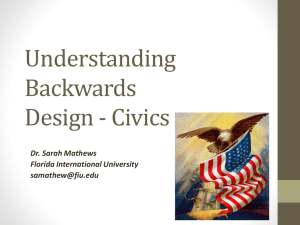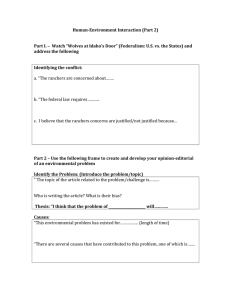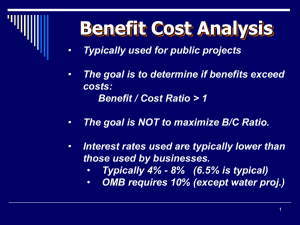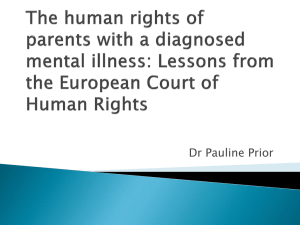Understanding Backwards Design
advertisement
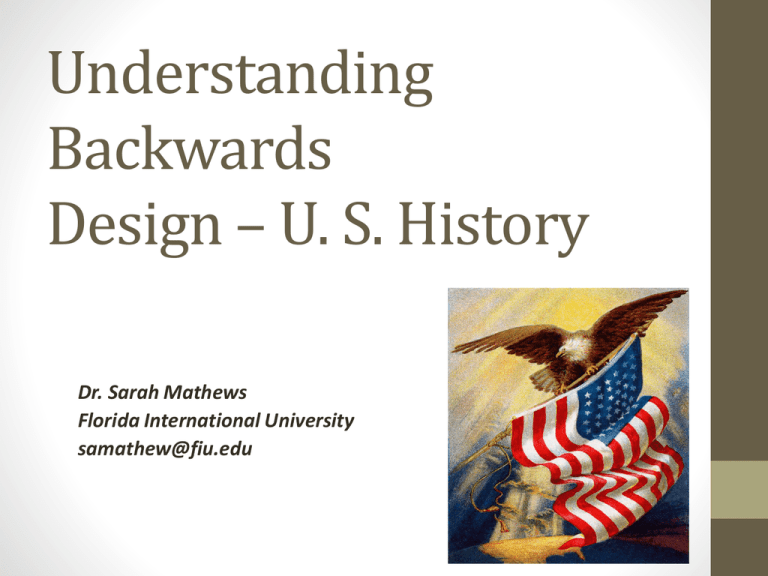
Understanding Backwards Design – U. S. History Dr. Sarah Mathews Florida International University samathew@fiu.edu PRESENTATION INFLUENCED BY GRANT WIGGINS AND JAY MCTIGHE’S UNDERSTANDING BY DESIGN (2006) Key Ideas of UbD • Start at the End • Identify Big Ideas • Generate Essential Questions • Attach Objectives to Assessments • Plan Learning Activities Avoid “Twin Sins of Traditional Design” • 1st Form: Activity Focused = “Hands-on activities that are not minds-on.” • 2nd Form: Coverage Focused = “Marching through textbook in a whirlwind attempt to cover every piece of factual information.” Backward Design Approach – Teaching for Understanding • Step One: What questions can Motivate student learning? (Essential Questions) • Step Two: What are the Core Understandings from this unit? (6 Facets of Understanding) • Step Three: How can students Demonstrate these Understandings? (Assessment) • Step Four: Which Activities can Facilitate learning? (Learning Plan) • Step Five: How can we use Student Performance Data to Adapt our teaching? (Evaluation and Reflection) Essential Questions • There are fundamental, recurring social questions in history • Focusing on these recurring questions helps make social studies more relevant to today’s world. • No “Finite” “Right/Wrong” answer • Provocative or Thought-provoking • Incorporate core ideas and inquiries within a discipline Examples of Overarching Essential questions 1. What actions are justified in the interest of the welfare or security of the community? 2. What standards must be met to give leadership legitimate authority? 3. When are citizens justified in resisting governmental authority? 4. What should society do to promote fairness and justice for people who live within its jurisdiction? 5. What is the best way to distribute a society’s resources? 3. When are citizens justified in resisting governmental authority? • What are justifiable means for seeking social change? • When is an individual justified in placing personal moral beliefs above societal norms? • What forms of dissent from governmental authority are justified? • When are citizens justified in forcible opposition to existing authority? • When are citizens justified in withdrawing their consent and seeking political separation from an established state? NOW YOU TRY Identifying Big Ideas • Broad and abstract • Represented by one or two words • Universal in application • Timeless • Represented by different examples • Provide a lens for study • Requires “uncoverage” • Can transfer to other areas Clarifying Content Priorities Worth Being Familiar With Important to Know and Do Big Ideas and Core Tasks Examples • Perspective • Large versus Narrow Government • Movements for Social Change • Now You Try… 6 Facets of Understanding • Explanation • Interpretation • Application • Perspectives • Empathy • Self-Knowledge NOW YOU TRY Step Three: Determining Evidence of Understanding • What types of Evidence do we need? • What specific Characteristics in students’ products or performances should we examine? • Does this Evidence enable us to infer students’ level of understanding, skill-set, or disposition? Range of Examples • Informal checks for understanding • Observations and dialogues • Tests and quizzes • Academic prompts • Performance tasks Two Questions to Ask • Could the proposed criteria be met but the performer still not demonstrate deep understanding? • Could the proposed criteria not be met but the performer still show understanding? Step Four: Plan Learning Activities - WHERETO • W – Ensure that students understand Where the unit is headed and Why • H – Hook students in the beginning and Hold their attention • E – Equip students with experiences, tools, knowledge, etc. to accomplish performance goals. • R – Provide opportunities to Rethink big ideas, Reflect on progress and Revise their work • E – Build in opportunities for students to Evaluate their progress • T – Be Tailored to reflect individuals talents, styles, skills O – Be Organized for deep understanding Step Five: How can we use Student Performance Data to adapt our teaching? • Which students Understood what we wanted them to understand? • What Remediation can we provide for students that might need more time or instruction? • What Enrichment can we provide for students that may have already grasped skills or concepts? • How can we teach students to Self-Assess their own learning? Thank You! Sarah Mathews Florida International University Department of Teaching and Learning, Social Studies samathew@fiu.edu
